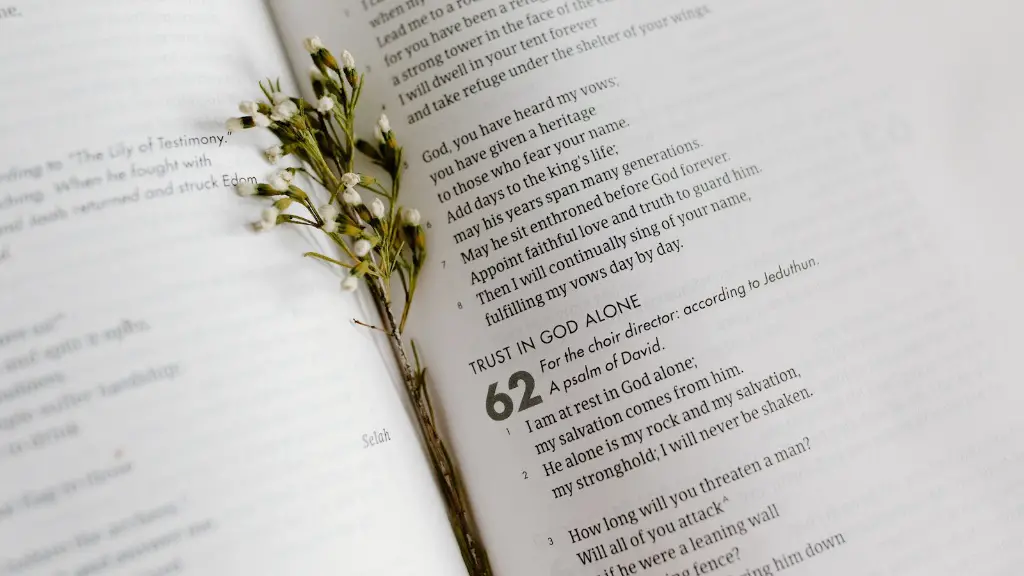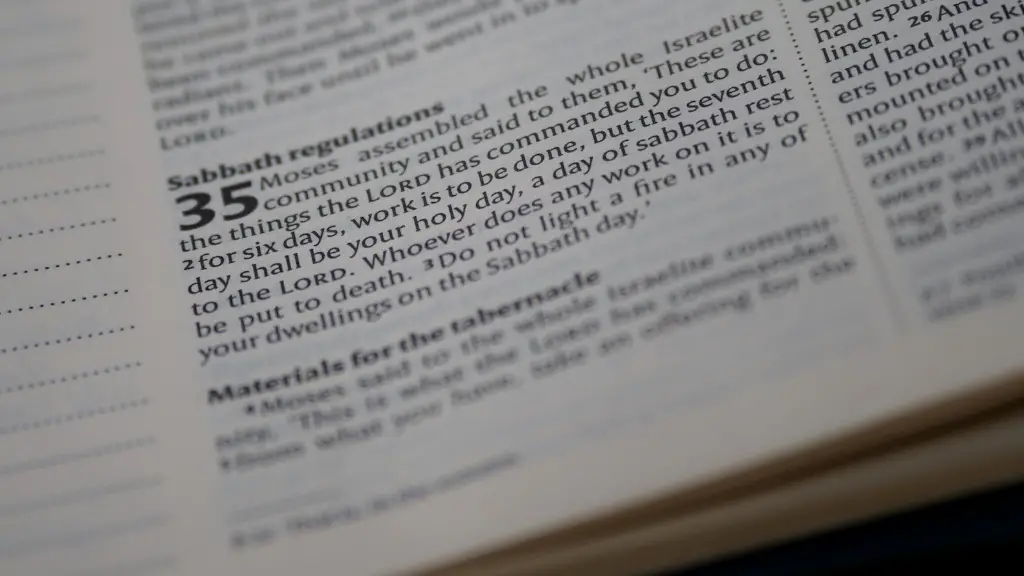Locating The Story Of Jesus’ Birth In The Bible
For Christians, the story of Jesus’ birth is a significant part of their beliefs and is often regarded as the most important event of the Christian faith. Where exactly in the Bible, though, is the story of Jesus’ birth found? The answer is that the actual story of Jesus’ birth is found in two different books in the Bible, the Gospel of Luke and the Gospel of Matthew.
In the Gospel of Luke, the story of Jesus’ birth is located in Chapter 2. The story begins with the annunciation of Jesus’ birth to the Virgin Mary. It then goes on to describe the journey to Bethlehem and the birth of Jesus in a stable while shepherds and wise men witness the event. It also recounts the circumstances surrounding Jesus’ circumcision on the eighth day of his life.
The Gospel of Matthew, meanwhile, gives a brief account of Jesus’ birth in Chapter 1. An angel of the Lord visits Joseph in a dream and tells him of Mary’s miraculous conception through the power of the Holy Spirit. Joseph accepts the news, the Virgin Mary gives birth to the baby Jesus, and they arrange for his circumcision.
The story of Jesus’ birth is rich with symbolism and meaning for Christians. The long journey of Mary and Joseph to Bethlehem, for example, was seen by Christians in the past to represent a parallel journey of the entire human race towards salvation. The stable in which Jesus was born is also seen as a sacred place, symbolising how God’s favour lies not with those in positions of worldly power, but the humble and lowly.
The arrival of the wise men, bringing gifts of gold, frankincense and myrrh, reflects how God is accessible to people of all nations and social status. Meanwhile, the angels’ message to the shepherds in Luke 2:10-14 is also an important part of the story, as it represents the message of hope and joy being brought to mankind.
Whilst there are some other references to Jesus’ birth in third-person in the Old Testament, the two books in the New Testament are the primary sources of information on the actual events of Jesus’ birth. Taken together, the accounts in Luke and Matthew provide a detailed and richly symbolic narrative of one of the most important moments in Christian belief.
Context Of Jesus’ Birth
The birth of Jesus is not just a standalone event but has to be seen in the context of the wider biblical narrative. In the Old Testament, the books of Isaiah and Micah, amongst others, make reference to a coming Messiah who would bring salvation to the Jews. Therefore, Jesus’ birth can be seen as the fulfilment of an ancient prophecy.
The Gospel writers also saw the birth of Jesus as the fulfilment of prophecy. Matthew, for example, quotes the prophet Isaiah in Chapter 1 and uses the language of the Jewish scriptures to discuss the coming of the Messiah. In Luke, too, the Annunciation of the birth speaks of a coming Saviour and King, with references to ‘his kingdom’.
Jesus’ birth can also be contextualized according to the events of the time. The Gospel of Luke includes the census of Quirinius as the reason for Mary and Joseph travelling to Bethlehem, indicating the year in which Jesus was born and placing the events in a historical context. Furthermore, the visit of the Magi and their gifts of gold, frankincense and myrrh may have been a reference to the imperial structures of the Roman Empire at the time.
Contextualizing the events of Jesus’ birth then, adds to the significance of the passage. It adds an added layer of meaning to the story, showing not only the prophetic fulfilment of ancient prophecies but also the relevance of Jesus’ birth to contemporary events.
Interpretations Of Jesus’ Birth
The story of Jesus’ birth has been open to a variety of interpretations over the centuries. Biblical exegesis has played an important role in drawing out the deeper meanings and symbolism from the story. The early Church Fathers interpreted the birth of Jesus in a variety of ways, from Jovinian’s focus on the human and divine nature of Jesus to Origen’s emphasis on the spiritual significance of the event.
In more modern times, too, theologians and commentators have used various degrees of allegorical interpretation to unpack the meaning of Jesus’ birth. C.S Lewis, for example, wrote of how the Christmas story symbolizes how God is willing to come down to man’s level, transforming even the humblest of circumstances into something miraculous and awe-inspiring.
The Christian interpretation of the birth of Jesus, then, is not a static one. It has evolved and been open to re-interpretation down the centuries, a reflection of the richness of the biblical text itself.
Implications Of Jesus’ Birth
The implications of Jesus’ birth for Christians are profound. On a theological level, the birth of Jesus shows how God is willing to take flesh in order to be with us and save us from sin. On a more practical level, it is seen as the starting point of a journey towards our own salvation.
The role of the Church in celebrating Jesus’birth is also an important one. It serves as a reminder of the importance of Jesus’ birth for Christians, as well as a way of bringing the story to the present day so that its message continues to be accessible for people of all ages and backgrounds.
It is perhaps not surprising, then, that Christmas is seen as the most powerful and meaningful celebration of the Christian faith, a time when the events of long ago are remembered and celebrated in the present. As such, the story of Jesus’ birth serves as a reminder of the power of God’s love and the hope it brings even in the darkest of times.
Symbols Associated With Jesus’ Birth
A key part of celebrating Jesus’ birth is by understanding and exploring the symbolism associated with it. The star of Bethlehem, for example, is seen as a sign of the coming of a new king. The stable in which Jesus was born, meanwhile, is a reminder of the humility of God’s mission on earth and his willingness to identify with the most humble and vulnerable.
The gifts of the wise men, too, are said to represent the value that God places on all human beings, regardless of their social status. The shepherds are seen as representing the ‘little people’ and how the message of Jesus’ birth is accessible to all, not just the educated elite.
The Christmas tree, too, is seen as an important symbol associated with Jesus’ birth, representing faith, hope and joy, and being a reminder of the events of long ago. Other symbols associated with Jesus’ birth include the manger, the angels, the donkey and the ox.
Understanding the symbols associated with the birth of Jesus, then, is an essential part of understanding Jesus’ life and mission. It adds an extra layer of meaning and relevance to the story and serves as a reminder of the importance of Jesus’ birth even today.
The Impact Of Jesus’ Birth Today
The birth of Jesus has had an immense impact on the world and continues to do so today. On the one hand, Christians see it as a reminder of the power of God’s love and the hope it brings, whilst on the other hand, it serves as an inspiration and a source of hope and joy for many non-Christians as a chance to share in a moment of peace and unity.
The impact of Jesus’ birth is also felt on a more personal level. For many people, the story of the nativity provides a sense of comfort and inspiration in the midst of life’s struggles, a reminder that no matter how hard the circumstances we face, God’s love and grace are ever present in our lives.
The events of Jesus’ birth also have wider implications for society. The story of Mary and Joseph, for example, is seen as a reminder of hospitality, of how God is willing to bring his love to all people, regardless of their faith or background. In this way, the story of Jesus’ birth is a reminder of God’s commitment to justice, equality and inclusivity.
Overall, then, the story of Jesus’ birth is a profoundly significant one for both Christians and non-Christians. Its symbols, meanings and implications are timeless, and its reminder of God’s love and grace can be found in the events of two thousand years ago as much as they can be found in the world today.





